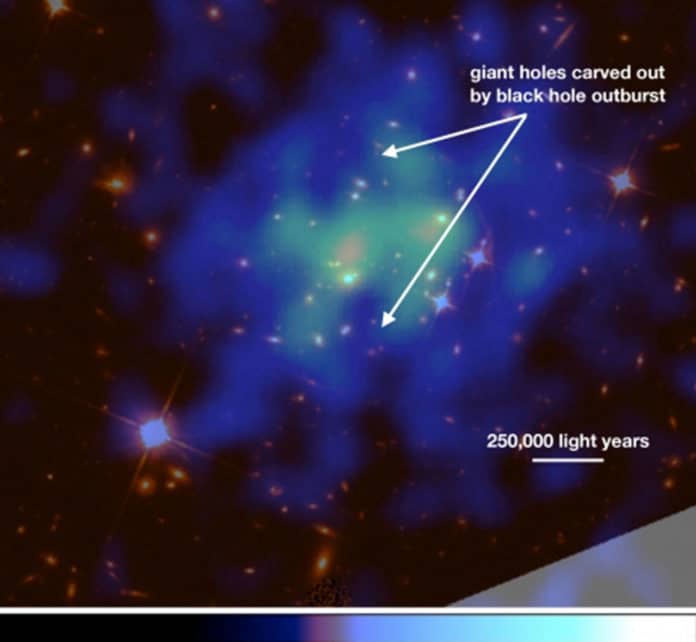Supermassive black holes gobble up everything around them. Billions of years ago, a black hole spewed out jets of plasma and created two large cavities 180 degrees from each other. The size of cavities helps estimate the energy of an asteroid impact by the size of its crater.
Likewise, using the size of these cavities, Michael Calzadilla, a graduate student at the MIT Kavli Institute for Astrophysics and Space Research (MKI), figure out the power of the black hole’s outburst.
Calzadilla measured the outburst in galaxy cluster SPT-CLJ0528-5300, or SPT-0528 for short. Along with his coauthors, Calzadilla combined the volume and pressure of the displaced gas with the age of the two cavities. Doing this allowed them to calculate the total energy of the outburst.
At greater than 1,054 joules of energy, a force equivalent to about 1,038 nuclear bombs, this is the most powerful outburst reported in a distant galaxy cluster.
Calzadilla said, “This is an extreme case of the outburst phase. Even though the outburst happened billions of years ago, before our solar system had even formed, it took around 6.7 billion years for light from the galaxy cluster to travel to Chandra, NASA’s X-ray emissions observatory that orbits Earth.”
The recorded outburst in SPT-0528 has another peculiarity that separates it from other black hole outbursts. It’s pointlessly enormous. Astronomers think about the procedure of gas cooling and hot gas discharge from black holes as an equilibrium that keeps the temperature in the galaxy cluster — which drifts around 18 million degrees Fahrenheit — stable.
Calzadilla said, “If you look at how much power is released as the gas cools onto the black hole versus how much power is contained in the outburst, the outburst is vastly overdoing it.”
Assistant professor of physics Michael McDonald said, “the outburst in SPT-0528 is a faulty thermostat. It’s as if you cooled the air by 2 degrees, and thermostat’s response was to heat the room by 100 degrees.”
The study is published in The Astrophysical Journal Letters.
